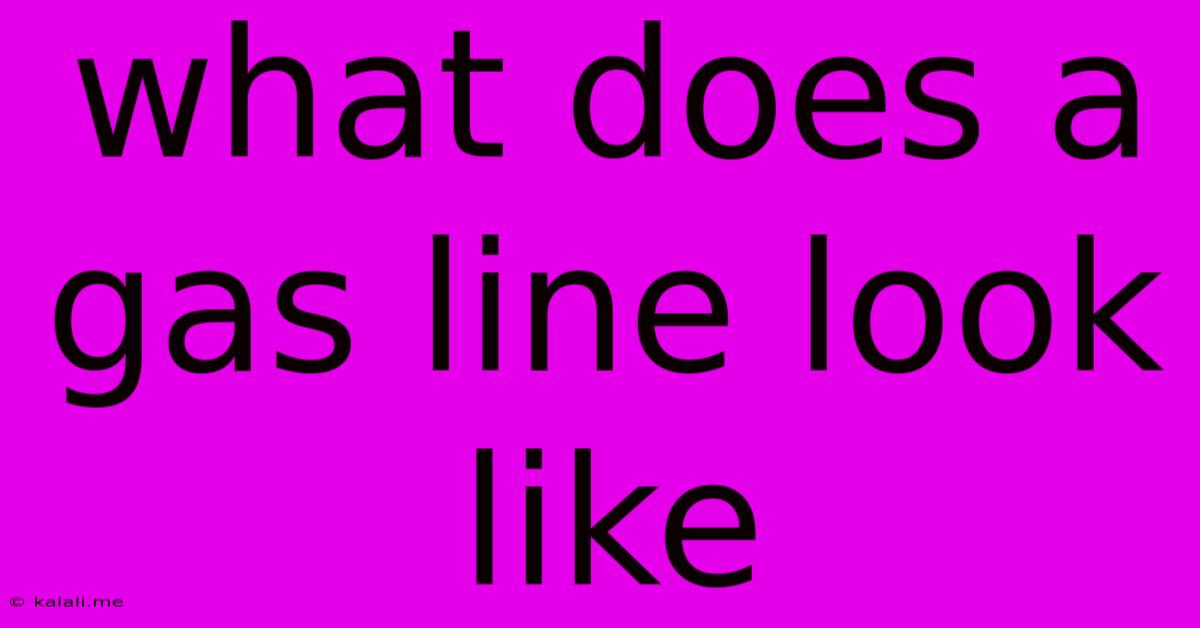What Does A Gas Line Look Like
Kalali
Jun 07, 2025 · 3 min read

Table of Contents
What Does a Gas Line Look Like? A Comprehensive Guide
Identifying a gas line correctly is crucial for safety and avoiding potential hazards. This guide will help you understand what a gas line looks like, its different types, and key features to recognize it. Knowing what a gas line looks like can help prevent accidents and ensure safe handling of natural gas.
Gas lines, responsible for transporting natural gas from its source to homes and businesses, come in various sizes and materials. They are typically underground, but can also be visible above ground, especially near appliances. Understanding their appearance is critical for both homeowners and professionals.
Types of Gas Lines and Their Appearance
Gas lines vary significantly depending on their purpose and location. Here's a breakdown of common types:
-
Underground Gas Lines: These are usually made of high-density polyethylene (HDPE) pipe. You won't typically see these unless there's excavation work. However, you might notice small yellow-coated markers indicating their presence. These markers are crucial and should never be disturbed.
-
Above-Ground Gas Lines: These are often made of black iron pipe or galvanized steel pipe, although newer installations may use HDPE. They're usually painted yellow or have yellow stripes for easy identification. The pipes themselves might be relatively thick and have fittings and valves along their length. You'll commonly find above-ground lines running to gas appliances like furnaces, water heaters, or stoves.
-
Gas Meters: The gas meter is a crucial component of your gas line system. It's typically a metal box, often painted gray or metallic colors, attached to the exterior of your home. It measures the amount of gas used. It will have a series of dials and possibly a digital display.
-
Gas Line Connectors: These connect the gas line to your appliances. They are typically made of metal and feature various fittings depending on the appliance. They often include flexible connectors to allow for some movement. These connectors are typically shorter in length than the main gas lines.
-
Gas Valves: These are crucial safety devices found along the gas line. They allow for the control and shutoff of gas flow in case of emergencies. They usually have a handle or knob that can be turned to open or close the valve.
Key Features to Identify a Gas Line:
- Color Coding: The most common visual indicator is yellow paint or yellow stripes. This is a universal standard to easily identify gas lines.
- Material: The material can vary, but generally, it will be a relatively sturdy and durable metal pipe or HDPE.
- Fittings and Valves: Gas lines typically include various fittings (joints, elbows) and valves to control the gas flow.
- Location: They are usually located underground or running along exterior walls to appliances.
- Warnings: Always be cautious around any suspected gas lines. If you are unsure, contact a qualified gas professional.
Safety Precautions Around Gas Lines:
- Never dig near suspected gas lines without contacting your local utility company. They can mark the location of the gas lines to prevent accidental damage. Calling 811 before you dig is a vital step.
- Avoid damaging or tampering with gas lines. Even a small puncture can lead to a dangerous gas leak.
- Report any suspected gas leaks immediately to your gas company. Gas leaks can be very dangerous and should be dealt with immediately by qualified technicians. Signs of a leak can include the smell of rotten eggs (a common additive to natural gas for detection), hissing sounds, or dead vegetation near the line.
Understanding what a gas line looks like is vital for safety and the proper maintenance of your gas appliances. Remember to always prioritize safety and contact a qualified professional if you have any doubts or concerns.
Latest Posts
Latest Posts
-
Inverse Tangent Of Square Root Of 3
Jun 07, 2025
-
How To Keep Sheets On Bed
Jun 07, 2025
-
Fallout 4 Leave Dogmeat At Home
Jun 07, 2025
-
How To Replace A Fireplace Insert
Jun 07, 2025
-
Wifi Says Saved Secured But Wont Connect
Jun 07, 2025
Related Post
Thank you for visiting our website which covers about What Does A Gas Line Look Like . We hope the information provided has been useful to you. Feel free to contact us if you have any questions or need further assistance. See you next time and don't miss to bookmark.